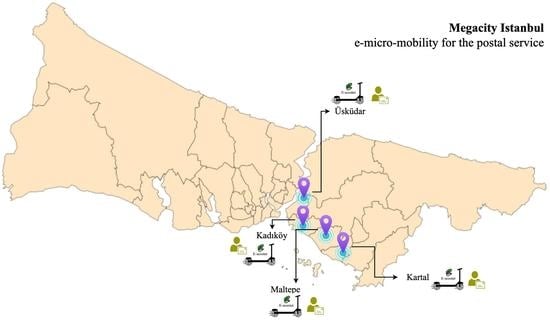E-Scooter Micro-Mobility Application for Postal Service: The Case of Turkey for Energy, Environment, and Economy Perspectives
Abstract
1. Introduction
- are very suitable for providing transit first and last mile connections due to their low cost and high flexibility [38],
- almost minimizing delivery time as long as a parking option is available [38],
- have short charging cycles, which usually take place at night, and have the flexibility to recharge [39];
- the range distance is 30–90 km,
- easy supply of spare parts, such as additional provinces, so that distribution operation are not disrupted,
2. Materials and Methods
2.1. Data
2.2. Statistical Analysis
2.3. Optimization Models
- for maximization problems:
- for minimization problems:
- for target values of the objective functions:
3. Results
3.1. Statistical Results of Poisson Distribution Regression Analysis
3.2. Comparison of the Economy, Energy, and Environmental Dimensions of the E-Scooter Model with Other Vehicles Used in the Package Distribution
3.2.1. Cost Analyses
3.2.2. Energy Analyses
3.2.3. Environmental Analyses
3.3. Results of the Optimization Models
4. Discussion
5. Conclusions
Author Contributions
Funding
Institutional Review Board Statement
Informed Consent Statement
Data Availability Statement
Conflicts of Interest
Appendix A

References
- Brown, A.; Klein, N.J.; Thigpen, C.; Williams, N. Impeding access: The frequency and characteristics of improper scooter, bike, and car parking. Transp. Res. Interdiscip. Perspect. 2020, 4, 100099. [Google Scholar] [CrossRef]
- Agriesti, S.; Brevi, F.; Gandini, P.; Marchionni, G.; Parmar, R.; Ponti, M.; Studer, L. Impact of driverless vehicles on urban environment and future mobility. Transp. Res. Procedia 2020, 49, 44–59. [Google Scholar] [CrossRef]
- Inac, H.; Oztemel, E. An Assessment Framework for the Transformation of Mobility 4.0 in Smart Cities. Systems 2021, 10, 1. [Google Scholar] [CrossRef]
- Iwan, S.; Kijewska, K.; Lemke, J. Analysis of parcel lockers’ efficiency as the last mile delivery solution—The results of the research in Poland. Transp. Res. Procedia 2016, 12, 644–655. [Google Scholar] [CrossRef]
- Kiziltaş, M.Ç.; Ayözen, Y. A Review of Electrical Bicycle Sharing Systems as an Innovative Application. Eur. J. Sci. Technol. 2022, 38, 270–275. [Google Scholar] [CrossRef]
- Sareen, S.; Remme, D.; Haarstad, H. E-scooter regulation: The micro-politics of market-making for micro-mobility in Bergen. Environ. Innov. Soc. Transit. 2021, 40, 461–473. [Google Scholar] [CrossRef]
- Kjærup, M.; Skov, M.B.; van Berkel, N. E-Scooter Sustainability—A Clash of Needs, Perspectives, and Experiences. In Proceedings of the Human-Computer Interaction—INTERACT 2021, Bari, Italy, 30 August–3 September 2021; Ardito, C., Lanzilotti, R., Malizia, A., Petrie, H., Piccinno, A., Desolda, G., Inkpen, K., Eds.; Springer International Publishing: Cham, Switzerland, 2021; pp. 365–383. [Google Scholar]
- Ebner, C.; Danzer, K.; Platz, C. Batteriepackage des E-Scooter-Konzepts von BMW Motorrad. ATZ-Automob. Zeitschrift 2012, 114, 248–253. [Google Scholar] [CrossRef]
- Shaheen, S.A.; Cohen, A.P.; Broader, J.; Davis, R.; Brown, L.; Neelakantan, R.; Gopalakrishna, D. Mobility on Demand Planning and Implementation: Current Practices, Innovations, and Emerging Mobility Futures; Department of Transportation, Intelligent Transportation Systems Joint Program Office: Washington, DC, USA, 2020. [Google Scholar]
- Castiglione, M.; Comi, A.; De Vincentis, R.; Dumitru, A.; Nigro, M. Delivering in Urban Areas: A Probabilistic-Behavioral Approach for Forecasting the Use of Electric Micromobility. Sustainability 2022, 14, 9075. [Google Scholar] [CrossRef]
- Schoemaker, J.; Allen, J.; Huschebeck, M.; Monigl, J. Quantification of Urban Freight Transport Effects I, Deliverable D5. 1; BESTUFS Project: Zoetermeer, The Netherlands, 2005. [Google Scholar]
- European Commission. MDS Transmodal and CTL (2012). Study on Urban Freight Transport. Final Report for DGMOVE of the European Commission; European Commission: Brussels, Belgium, 2022.
- Bieliński, T.; Ważna, A. Electric Scooter Sharing and Bike Sharing User Behaviour and Characteristics. Sustainability 2020, 12, 9640. [Google Scholar] [CrossRef]
- Aman, J.J.C.; Smith-Colin, J.; Zhang, W. Listen to E-scooter riders: Mining rider satisfaction factors from app store reviews. Transp. Res. Part D Transp. Environ. 2021, 95, 102856. [Google Scholar] [CrossRef]
- Siddiqui, S.; Makrakis, D. Mpls-Based Micro-Mobility Architecture for 5g Vehicular Visible Light Communication Networks. In Proceedings of the 2020 International Symposium on Networks, Computers and Communications (ISNCC), Montreal, QC, Canada, 20–22 October 2020; IEEE: Manhattan, NY, USA, 2020; pp. 1–7. [Google Scholar]
- Nocerino, R.; Colorni, A.; Lia, F.; Luè, A. E-bikes and E-scooters for Smart Logistics: Environmental and Economic Sustainability in Pro-E-bike Italian Pilots. Transp. Res. Procedia 2016, 14, 2362–2371. [Google Scholar] [CrossRef]
- Heumann, M.; Kraschewski, T.; Brauner, T.; Tilch, L.; Breitner, M.H. A Spatiotemporal Study and Location-Specific Trip Pattern Categorization of Shared E-Scooter Usage. Sustainability 2021, 13, 12527. [Google Scholar] [CrossRef]
- Jiao, J.; Bai, S. Understanding the Shared E-scooter Travels in Austin, TX. ISPRS Int. J. Geo-Inf. 2020, 9, 135. [Google Scholar] [CrossRef]
- Jettanasen, C.; Songsukthawan, P.; Ngaopitakkul, A. Development of micro-mobility based on piezoelectric energy harvesting for smart city applications. Sustainability 2020, 12, 2933. [Google Scholar] [CrossRef]
- Wu, H.; Dunn, S.C. Environmentally responsible logistics systems. Int. J. Phys. Distrib. Logist. Manag. 1995, 25, 20–38. [Google Scholar] [CrossRef]
- Mekhilef, S.; Saidur, R.; Safari, A. Comparative study of different fuel cell technologies. Renew. Sustain. Energy Rev. 2012, 16, 981–989. [Google Scholar] [CrossRef]
- Gebhardt, L.; Wolf, C.; Seiffert, R. “I’ll Take the E-Scooter Instead of My Car”—The Potential of E-Scooters as a Substitute for Car Trips in Germany. Sustainability 2021, 13, 7361. [Google Scholar] [CrossRef]
- Andreev, P.I.; Rupen Aprahamian, B.; Todorov, M.; Zhelev, G. Study of “MI Electric Scooter Pro” Capabilities. In Proceedings of the 2020 21st International Symposium on Electrical Apparatus & Technologies (SIELA), Bourgas, Bulgaria, 3–6 June 2020; IEEE: Manhattan, NY, USA, 2020; pp. 1–4. [Google Scholar]
- Fu, Z.; Zhang, Y.; He, S.; Wang, H.; Jiang, X.; Wang, S. Multi-objective programming for economy–energy–environment system and policy mix with dual constraints of carbon emission and water consumption based on multi-scenario analysis. Energy Rep. 2022, 8, 7884–7891. [Google Scholar] [CrossRef]
- Jia, Z.; Lin, B. CEEEA2.0 model: A dynamic CGE model for energy-environment-economy analysis with available data and code. Energy Econ. 2022, 112, 106117. [Google Scholar] [CrossRef]
- Miao, Z.; Zhang, Y.; Liu, S.; Chen, X.; Baležentis, T. Heterogeneous strategy and performance decomposition: Energy-economy-environment nexus in the light of natural & managerial disposability. Environ. Impact Assess. Rev. 2022, 95, 106777. [Google Scholar] [CrossRef]
- Wen, S.; Jia, Z. The energy, environment and economy impact of coal resource tax, renewable investment, and total factor productivity growth. Resour. Policy 2022, 77, 102742. [Google Scholar] [CrossRef]
- Zhang, S.; Yu, Y.; Kharrazi, A.; Ren, H.; Ma, T. Quantifying the synergy and trade-offs among economy–energy–environment–social targets: A perspective of industrial restructuring. J. Environ. Manag. 2022, 316, 115285. [Google Scholar] [CrossRef] [PubMed]
- Gebhardt, L.; Ehrenberger, S.; Wolf, C.; Cyganski, R. Can shared E-scooters reduce CO2 emissions by substituting car trips in Germany? Transp. Res. Part D Transp. Environ. 2022, 109, 103328. [Google Scholar] [CrossRef]
- Severengiz, S.; Finke, S.; Schelte, N.; Wendt, N. Life Cycle Assessment on the Mobility Service E-Scooter Sharing. In Proceedings of the 2020 IEEE European Technology and Engineering Management Summit (E-TEMS), Dortmund, Germany, 5–7 March 2020; IEEE: Manhattan, NY, USA, 2020; pp. 1–6. [Google Scholar]
- Wanganoo, L.; Shukla, V.; Mohan, V. Intelligent Micro-Mobility E-Scooter: Revolutionizing Urban Transport. In Trust-Based Communication Systems for Internet of Things Applications; John Wiley & Sons, Ltd.: Hoboken, NJ, USA, 2022; pp. 267–290. ISBN 9781119896746. [Google Scholar]
- Moreau, H.; de Jamblinne de Meux, L.; Zeller, V.; D’Ans, P.; Ruwet, C.; Achten, W.M.J. Dockless E-Scooter: A Green Solution for Mobility? Comparative Case Study between Dockless E-Scooters, Displaced Transport, and Personal E-Scooters. Sustainability 2020, 12, 1803. [Google Scholar] [CrossRef]
- Hollingsworth, J.; Copeland, B.; Johnson, J.X. Are e-scooters polluters? The environmental impacts of shared dockless electric scooters. Environ. Res. Lett. 2019, 14, 084031. [Google Scholar] [CrossRef]
- Quak, H.; Nesterova, N.; van Rooijen, T. Possibilities and barriers for using electric-powered vehicles in city logistics practice. Transp. Res. Procedia 2016, 12, 157–169. [Google Scholar] [CrossRef]
- Riggs, W.; Kawashima, M.; Batstone, D. Exploring best practice for municipal e-scooter policy in the United States. Transp. Res. Part A Policy Pract. 2021, 151, 18–27. [Google Scholar] [CrossRef]
- Lia, F.; Nocerino, R.; Bresciani, C.; Colorni Vitale, A.; Luè, A. Promotion of E-bikes for delivery of goods in European urban areas: An Italian case study. In Proceedings of the Transport Research Arena (TRA) 5th Conference: Transport Solutions from Research to Deployment, Paris, France, 14–17 April 2014; pp. 1–10. [Google Scholar]
- Abduljabbar, R.L.; Liyanage, S.; Dia, H. The role of micro-mobility in shaping sustainable cities: A systematic literature review. Transp. Res. Part D Transp. Environ. 2021, 92, 102734. [Google Scholar] [CrossRef]
- Zuniga-Garcia, N.; Tec, M.; Scott, J.G.; Machemehl, R.B. Evaluation of e-scooters as transit last-mile solution. Transp. Res. Part C Emerg. Technol. 2022, 139, 103660. [Google Scholar] [CrossRef]
- Yilmaz, M.; Krein, P.T. Review of battery charger topologies, charging power levels, and infrastructure for plug-in electric and hybrid vehicles. IEEE Trans. Power Electron. 2013, 28, 2151–2169. [Google Scholar] [CrossRef]
- Lee, H.; Baek, K.; Chung, J.-H.; Kim, J. Factors affecting heterogeneity in willingness to use e-scooter sharing services. Transp. Res. Part D Transp. Environ. 2021, 92, 102751. [Google Scholar] [CrossRef]
- Lacoste, M.; Weiss-Lambrou, R.; Allard, M.; Dansereau, J. Powered tilt/recline systems: Why and how are they used? Assist. Technol. 2003, 15, 58–68. [Google Scholar] [PubMed]
- Garber, S.L.; Bunzel, R.; Monga, T.N. Wheelchair utilization and satisfaction following cerebral vascular accident. J. Rehabil. Res. Dev. 2002, 39, 521–534. [Google Scholar] [PubMed]
- Evans, S.; Frank, A.O.; Neophytou, C.; De Souza, L. Older adults’ use of, and satisfaction with, electric powered indoor/outdoor wheelchairs. Age Ageing 2007, 36, 431–435. [Google Scholar] [CrossRef]
- Jedeloo, S.; De Witte, L.P.; Linssen, B.A.J.; Schrijvers, A.J.P. Client satisfaction with service delivery of assistive technology for outdoor mobility. Disabil. Rehabil. 2002, 24, 550–557. [Google Scholar] [CrossRef]
- Weinert, J.X. The Rise of Electric Two-Wheelers in China: Factors for Their Success and Implications for the Future; University of California: Davis, CA, USA, 2007; ISBN 0549494723. [Google Scholar]
- Schellong, D.; Sadek, P.; Schaetzberger, C.; Barrack, T. The promise and pitfalls of e-scooter sharing. Europe 2019, 12, 15. [Google Scholar]
- Tuncer, S.; Brown, B. E-scooters on the ground: Lessons for redesigning urban micro-mobility. In Proceedings of the 2020 CHI Conference on Human Factors in Computing Systems, Honolulu, HI, USA, 25–30 April 2020; pp. 1–14. [Google Scholar]
- Hayat, M.J.; Higgins, M. Understanding poisson regression. J. Nurs. Educ. 2014, 53, 207–215. [Google Scholar]
- Chesaniuk, M. Chapter 19: Logistic and Poisson Regression 2021. Available online: https://ademos.people.uic.edu/Chapter19.html (accessed on 21 September 2022).
- Eccarius, T.; Lu, C.-C. Adoption intentions for micro-mobility—Insights from electric scooter sharing in Taiwan. Transp. Res. Part D Transp. Environ. 2020, 84, 102327. [Google Scholar] [CrossRef]
- Reck, D.J.; Axhausen, K.W. Who uses shared micro-mobility services? Empirical evidence from Zurich, Switzerland. Transp. Res. Part D Transp. Environ. 2021, 94, 102803. [Google Scholar] [CrossRef]
- Bozzi, A.D.; Aguilera, A. Shared E-Scooters: A Review of Uses, Health and Environmental Impacts, and Policy Implications of a New Micro-Mobility Service. Sustainability 2021, 13, 8676. [Google Scholar] [CrossRef]
- Chiussi, F.A.; Khotimsky, D.A.; Krishnan, S. A network architecture for MPLS-based micro-mobility. In Proceedings of the 2002 IEEE Wireless Communications and Networking Conference Record. WCNC 2002 (Cat. No.02TH8609), Orlando, FL, USA, 17–21 March 2002; Volume 2, pp. 549–555. [Google Scholar]
- Zhao, P.; Haitao, H.; Li, A.; Mansourian, A. Impact of data processing on deriving micro-mobility patterns from vehicle availability data. Transp. Res. Part D Transp. Environ. 2021, 97, 102913. [Google Scholar] [CrossRef]
- Štefancová, V.; Kalašová, A.; Čulík, K.; Mazanec, J.; Vojtek, M.; Mašek, J. Research on the Impact of COVID-19 on Micromobility Using Statistical Methods. Appl. Sci. 2022, 12, 8128. [Google Scholar] [CrossRef]
- Liu, L.; Miller, H.J. Measuring the impacts of dockless micro-mobility services on public transit accessibility. Comput. Environ. Urban Syst. 2022, 98, 101885. [Google Scholar] [CrossRef]
- Sun, B.; Garikapati, V.; Wilson, A.; Duvall, A. Estimating energy bounds for adoption of shared micromobility. Transp. Res. Part D Transp. Environ. 2021, 100, 103012. [Google Scholar] [CrossRef]
- Medina-Molina, C.; Pérez-Macías, N.; Gismera-Tierno, L. The multi-level perspective and micromobility services. J. Innov. Knowl. 2022, 7, 100183. [Google Scholar] [CrossRef]
- PTT Turkish Post. Available online: https://www.ptt.gov.tr/ (accessed on 1 September 2022).
- Atalan, A. A cost analysis with the discrete-event simulation application in nurse and doctor employment management. J. Nurs. Manag. 2022, 30, 733–741. [Google Scholar] [CrossRef]
- Famoye, F.; Singh, K.P. Zero-inflated generalized Poisson regression model with an application to domestic violence data. J. Data Sci. 2006, 4, 117–130. [Google Scholar] [CrossRef]
- Consul, P.C.; Famoye, F. Generalized poisson regression model. Commun. Stat.-Theory Methods 1992, 21, 89–109. [Google Scholar] [CrossRef]
- Lu, Z.; Van Hui, Y.; Lee, A.H. Minimum Hellinger distance estimation for finite mixtures of Poisson regression models and its applications. Biometrics 2003, 59, 1016–1026. [Google Scholar] [CrossRef]
- Koç, H.; Dünder, E.; Gümüştekin, S.; Koç, T.; Cengiz, M.A. Particle swarm optimization-based variable selection in Poisson regression analysis via information complexity-type criteria. Commun. Stat.-Theory Methods 2018, 47, 5298–5306. [Google Scholar] [CrossRef]
- Gebski, V.; Ellingson, K.; Edwards, J.; Jernigan, J.; Kleinbaum, D. Modelling interrupted time series to evaluate prevention and control of infection in healthcare. Epidemiol. Infect. 2012, 140, 2131–2141. [Google Scholar] [CrossRef] [PubMed]
- Atalan, A.; Şahin, H.; Atalan, Y.A. Integration of Machine Learning Algorithms and Discrete-Event Simulation for the Cost of Healthcare Resources. Healthcare 2022, 10, 1920. [Google Scholar] [CrossRef]
- Lukman, A.F.; Adewuyi, E.; Månsson, K.; Kibria, B.M.G. A new estimator for the multicollinear Poisson regression model: Simulation and application. Sci. Rep. 2021, 11, 3732. [Google Scholar] [CrossRef] [PubMed]
- Hamdy, T.A. Operations Research: An Introduction, 9th ed.; Pearson: Upper Saddle River, NJ, USA, 2010. [Google Scholar]
- Atalan, A. Forecasting drinking milk price based on economic, social, and environmental factors using machine learning algorithms. Agribusiness 2022, 1–28. [Google Scholar] [CrossRef]
- Dönmez, N.F.K.; Atalan, A.; Dönmez, C.Ç. Desirability Optimization Models to Create the Global Healthcare Competitiveness Index. Arab. J. Sci. Eng. 2020, 45, 7065–7076. [Google Scholar] [CrossRef]
- Mistry, M.; Letsios, D.; Krennrich, G.; Lee, R.M.; Misener, R. Mixed-Integer Convex Nonlinear Optimization with Gradient-Boosted Trees Embedded. Optim. Control 2018, 33, 1–40. [Google Scholar] [CrossRef]
- Ayaz Atalan, Y.; Tayanç, M.; Erkan, K.; Atalan, A. Development of Nonlinear Optimization Models for Wind Power Plants Using Box-Behnken Design of Experiment: A Case Study for Turkey. Sustainability 2020, 12, 6017. [Google Scholar] [CrossRef]
- Saleem, M.; Farooq, U.; Izhar, U.; Khan, U. Multi-Response Optimization of Electrothermal Micromirror Using Desirability Function-Based Response Surface Methodology. Micromachines 2017, 8, 107. [Google Scholar] [CrossRef]
- Dönmez, C.Ç.; Atalan, A. Developing Statistical Optimization Models for Urban Competitiveness Index: Under the Boundaries of Econophysics Approach. Complexity 2019, 2019, 1–11. [Google Scholar] [CrossRef]
- Atalan, A. Desirability Optimization Based on the Poisson Regression Model: Estimation of the Optimum Dental Workforce Planning. Int. J. Health Manag. Tour. 2022, 7, 200–216. [Google Scholar] [CrossRef]
- Ruesch, M.; Schmid, T.; Bohne, S.; Haefeli, U.; Walker, D. Freight Transport with Vans: Developments and Measures. Transp. Res. Procedia 2016, 12, 79–92. [Google Scholar] [CrossRef][Green Version]
- Fuchs, A. Energie-effizienter Leicht-Scooter im Gewichtsbereich eines Mofa; Technical Report; Swiss Federal Office of Energy: Berne, Switzerland, 2005. [Google Scholar]
- Şengül, B.; Mostofi, H. Impacts of E-Micromobility on the Sustainability of Urban Transportation—A Systematic Review. Appl. Sci. 2021, 11, 5851. [Google Scholar] [CrossRef]
- Heineke, K.; Kloss, B.; Scurtu, D.; Weig, F. Micromobility’s 15,000-Mile Checkup; McKinsey Company: Chicago, IL, USA, 2019; Volume 29. [Google Scholar]
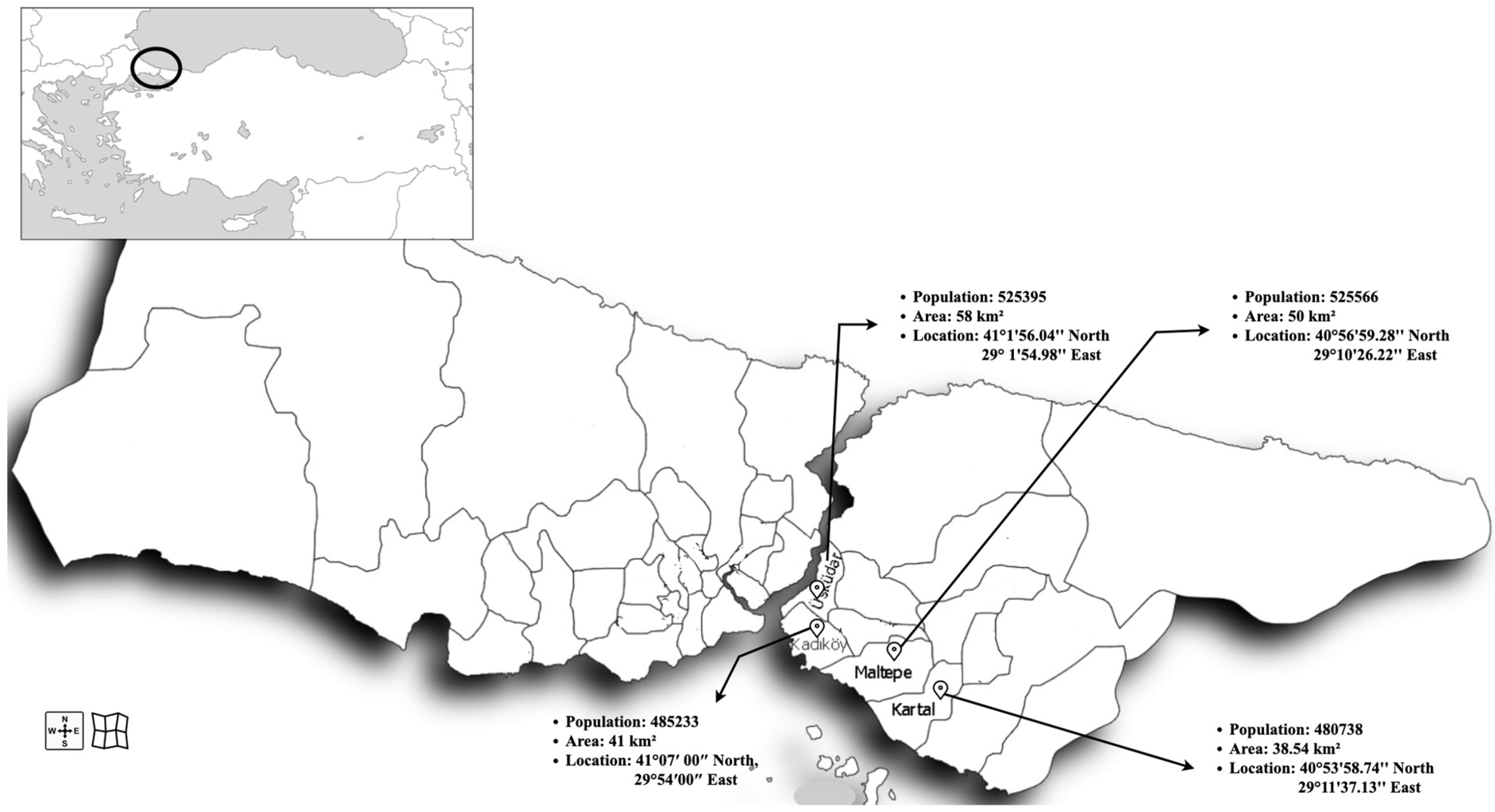



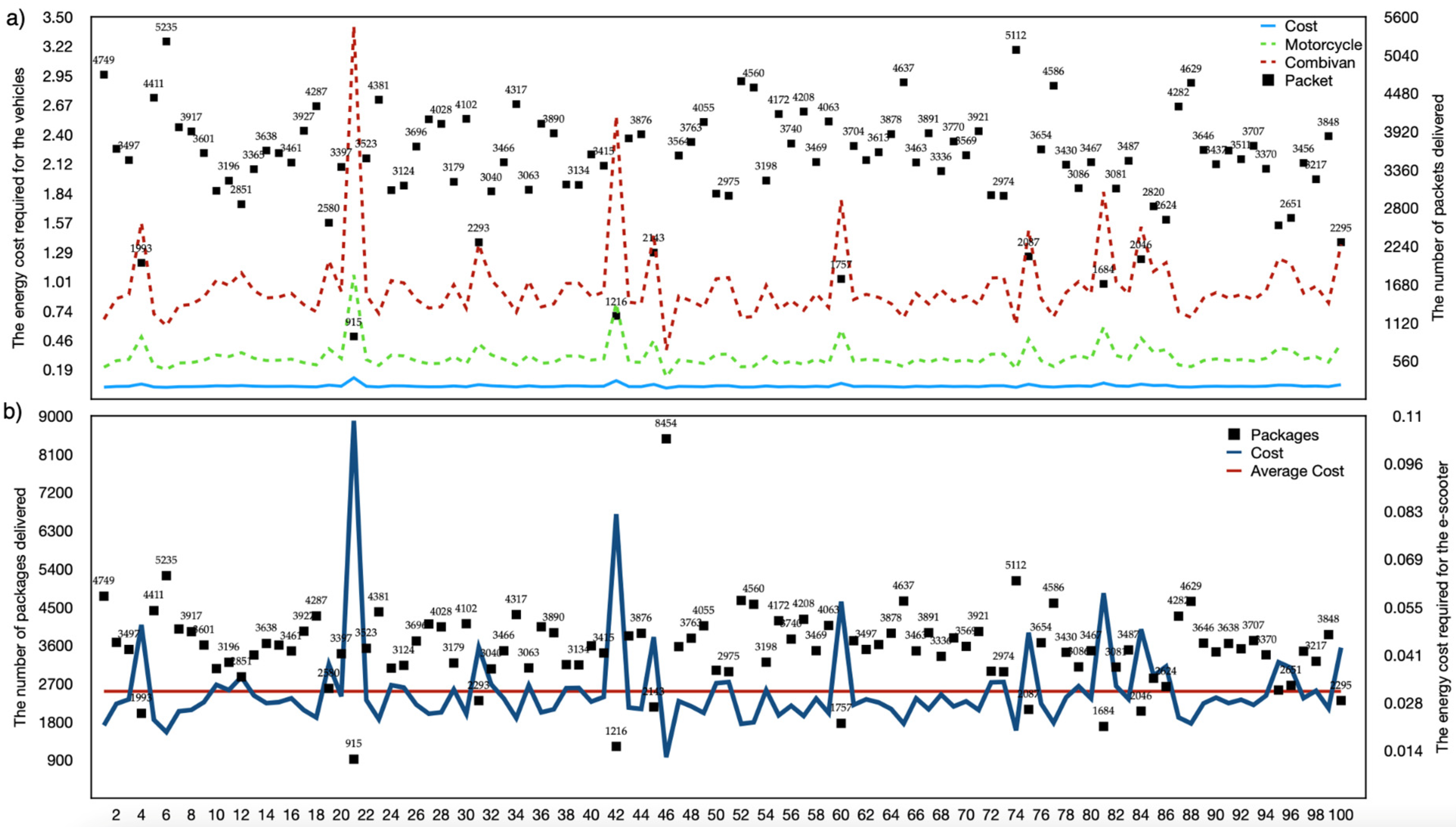
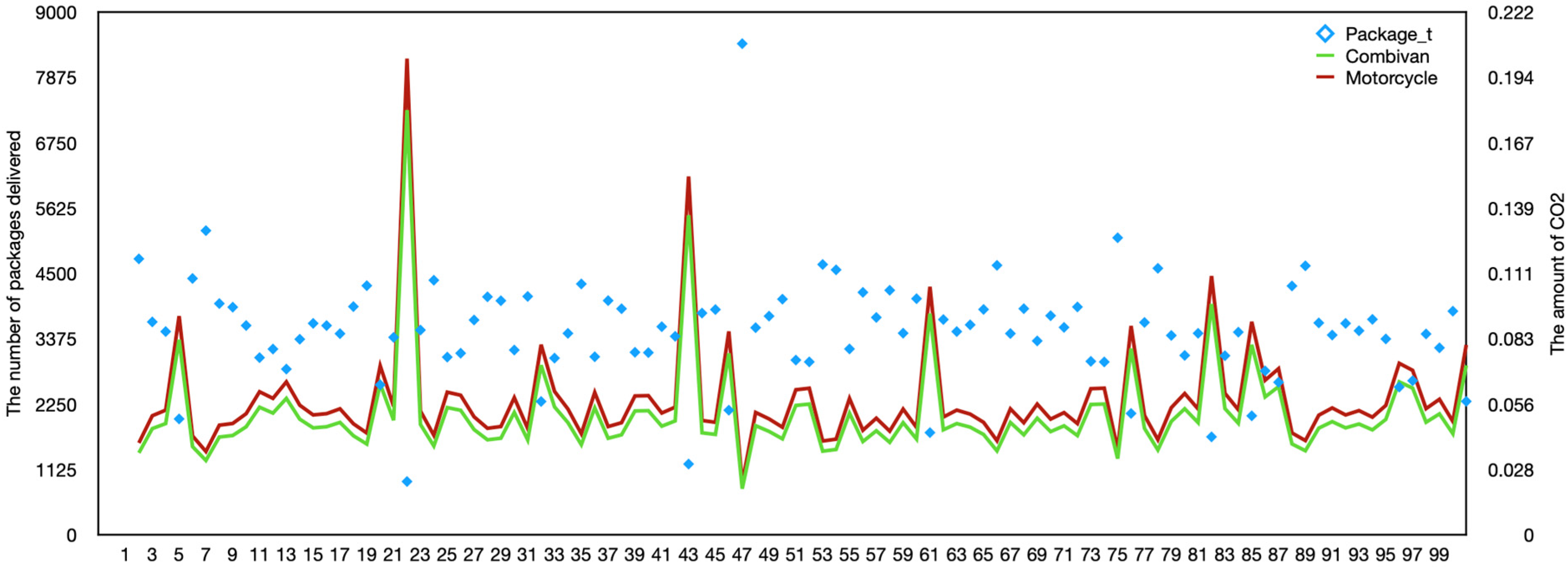

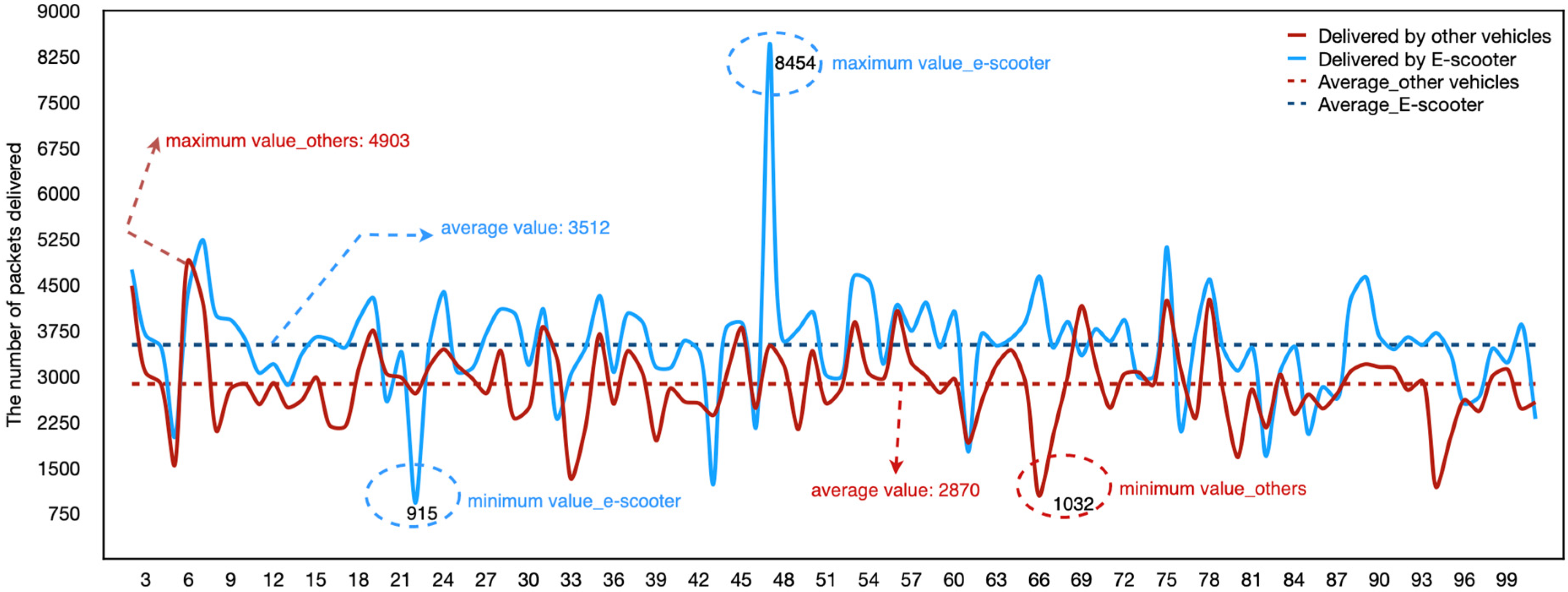
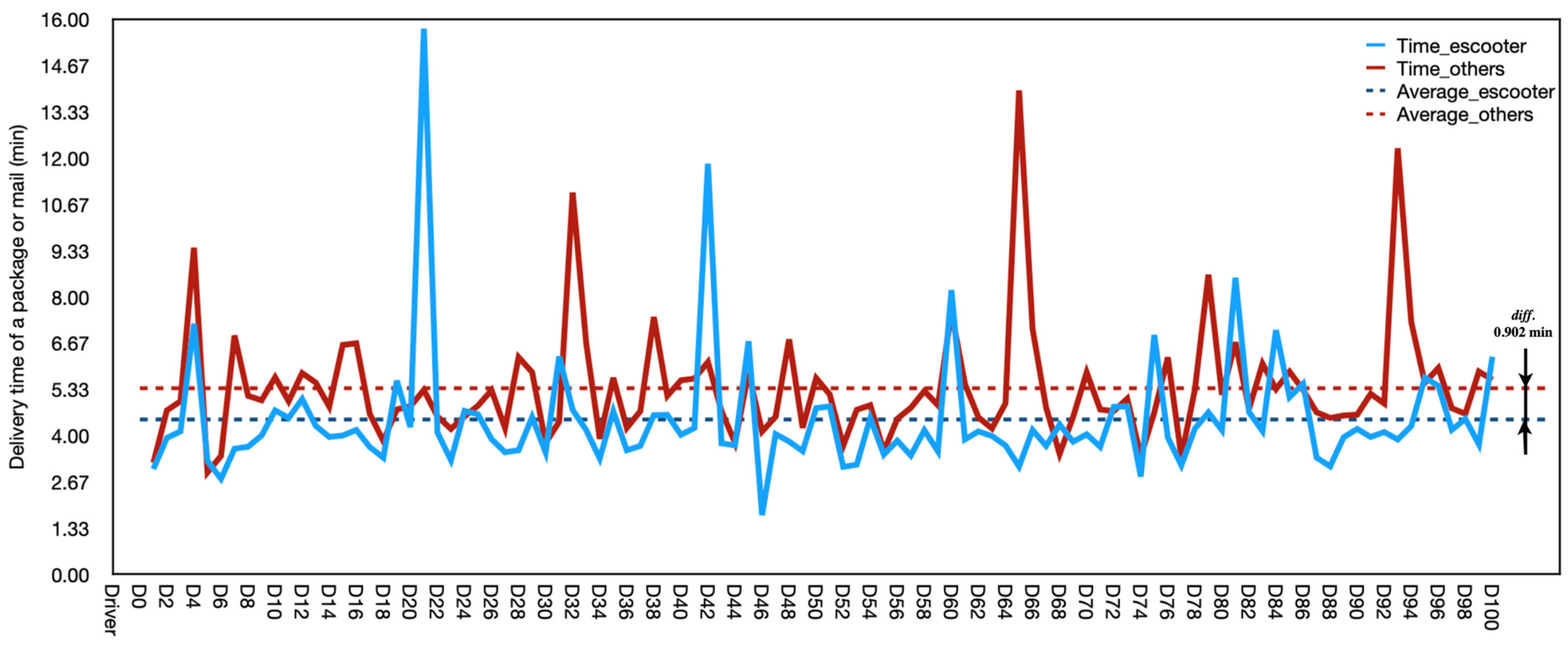
| Source | Purpose (s) | Factor (s) | Method (s) |
|---|---|---|---|
| [50] | To investigate the factors affecting the use of electric scooter sharing service by university students | Intention, Perceived behaviour control, attitude, subjective norm, compatibility, environmental value, awareness–knowledge | Factor analysis and structural equation modelling |
| [51] | Adoption of shared micro-mobility in the city of Zurich | Person-specific socio-demographic, household-specific socio-demographic, person-specific mobility questions | Maximum simulated likelihood |
| [52] | Review of uses of a new micro-mobility service | Health and environmental impacts, policy implications | Literature review |
| [53] | Building a new multi-protocol tag switching (MPLS) based network architecture that implements micro-mobility | Tunnel-based, routing-based schemes | Label edge mobility agent |
| [54] | Creating a potential data source for micro-mobility research and applications | A range of temporal, spatial, and statistical mobility descriptors | Data processing framework |
| [55] | Investigating the impact of COVID-19 on micro-mobility | Relax, health, speed, price, availability | Independence test, correspondence analysis |
| [56] | Establish accessibility increase measures for micro-mobility services | General transit feed specification (GTFS), the locations of available of dockless vehicle, the empirical transit usage | Accessibility increment, spatiotemporal analyses |
| [57] | Exploring the energy limits of shared micro-mobility adoption | Energy impacts: age, time of day, trip purpose, area types, travel party size, tour mode restriction | Sensitivity statistical analysis |
| [19] | Design of a pilot device to study the energy conversion and storage achieved by converting a micro-mobility device to a stationary exercise bike with a piezoelectric generator | Energy, environmental factors, piezoelectric materials | The piezoelectric material |
| [58] | To clarify how the system, regime, and niche dynamics that make up the MLP are interrelated | Landscape, regime, niche | Sociotechnical transition and the multi-level perspective |
| This Study | To deliver the maximum number of packages or mails with minimum cost and the shortest time | Cost, energy, environmental aspects | Poisson regression optimization model |
| Variables | Units | Status | Notations | Description |
|---|---|---|---|---|
| Number of packages delivered | Number, (Integer) | Response | The average number of packages delivered per hour by a worker | |
| The total cost of distribution * | TL | Response | The cost of distribution of packages to the administration includes energy, rent, and personnel expenses. | |
| Age | Year | Input | Age information of employees involved in the e-scooter package distribution project | |
| Gender | Categorical | Input | Gender information of employees engaged in the e-scooter package distribution project | |
| Tenure in the profession | Year | Input | Working times of employees involved in the e-scooter package delivery project in the delivery job (before the e-scooter project) | |
| Area | Km2 | Input | Area sizes for which the employees involved in the e-scooter package distribution project are responsible | |
| CO2 Emission | g/km | Input | The amount of CO2 emissions per package |
| Variable | Decision Variable | Response Variables | ||||||
|---|---|---|---|---|---|---|---|---|
| Cost_e-S | Cost_m | Cost_c | ||||||
| Mean | 33.51 | 7.326 | 0.468 | 0.054 | 3511.8 | 1791.0 | 10,535 | 73,748 |
| SE Mean | 0.761 | 0.595 | 0.032 | 0.002 | 91.500 | 46.700 | 275.0 | 1922 |
| StDev | 7.611 | 5.946 | 0.313 | 0.021 | 915.00 | 466.70 | 2745 | 19,216 |
| Variance | 57.92 | 35.36 | 0.098 | 0.001 | 83,728 | 21,778 | 7 × 106 | 3.69 × 108 |
| CoefVar | 22.71 | 81.17 | 66.99 | 39.04 | 26.060 | 26.060 | 26.06 | 26.06 |
| Minimum | 19.00 | 0.100 | 0.113 | 0.021 | 91,500 | 466.70 | 2745 | 19,215 |
| Q1 | 28.00 | 2.200 | 0.271 | 0.045 | 3082.3 | 1571.9 | 9247 | 64,727 |
| Median | 33.00 | 7.450 | 0.353 | 0.050 | 3517 | 1793.7 | 10,551 | 73,857 |
| Q3 | 38.75 | 11.05 | 0.565 | 0.057 | 3920 | 1999.2 | 11,760 | 82,320 |
| Maximum | 55.00 | 24.80 | 1.989 | 0.192 | 8454 | 4311.5 | 25,362 | 177,534 |
| Range | 36.00 | 24.70 | 1.876 | 0.171 | 7539 | 3844.9 | 22,617 | 158,319 |
| IQR | 10.75 | 8.850 | 0.294 | 0.012 | 837.8 | 427.30 | 2513 | 17,593 |
| Mode (Male, Female) | 31.00 | 8.300 | 0.051 | (3497, 3638) | (1784, 1856) | (10,491, 10,914) | (73,437, 76,398) | |
| N for Mode | 8.00 | 8.00 | 0.00 | 3.000 | 2.00 | 2.00 | 2.00 | 2.00 |
| Skewness | 0.33 | 0.91 | 2.52 | 3.840 | 1.10 | 1.10 | 1.10 | 1.10 |
| Kurtosis | −0.13 | 0.35 | 8.88 | 20.08 | 8.31 | 8.31 | 8.31 | 8.31 |
| Term | Model | Deviance | Pearson | ||||||
|---|---|---|---|---|---|---|---|---|---|
| Packages/ Mails | SE Coef. | 0.0123 | 0.0003 | 0.0004 | 0.0054 | 0.153 | 0.008 | ||
| Z-Value | 735.29 | −2.29 | −0.41 | 6.77 | −113.41 | −1.28 | |||
| p-Value | 0.0001 | 0.022 | 0.679 | 0.001 | 0.001 | 0.199 | 0.001 | 0.022 | |
| VIF | 1.67 | 1.69 | 1.04 | 1.06 | 1.01 | ||||
| R-Sq | 0.9024 | ||||||||
| R-Sq(adj) | 0.9021 | ||||||||
| DF | 5.000 | 1.000 | 1.000 | 1.00 | 1.00 | 1.00 | 89.00 | 89.00 | |
| Chi-Square | 13,973.4 | 5.26 | 0.17 | 45.82 | 12,862 | 1.65 | 1954.8 | 2463 | |
| Mean | 33.51 | 7.326 | 0.468 | 0.054 | 33.51 | 21.964 | 27.67 | ||
| Estimate | 9.0622 | −0.0007 | −0.0002 | 0.0364 | −17.33 | −0.01 | 1954.8 | 2463 | |
| Cost | SE Coef. | 0.0173 | 0.00041 | 0.0005 | 0.0075 | 0.214 | 0.011 | ||
| Z-Value | 486.09 | −1.64 | −0.3 | 4.83 | −80.99 | −0.92 | |||
| p-Value | 0.0001 | 0.101 | 0.767 | 0.001 | 0.000 | 0.36 | 0.001 | 0.001 | |
| VIF | 1.670 | 1.69 | 1.04 | 1.06 | 1.01 | ||||
| R-Sq | 0.9024 | ||||||||
| R-Sq(adj) | 0.9019 | ||||||||
| DF | 5.0000 | 1.00 | 1.000 | 1.00 | 1.00 | 1.00 | 89.00 | 89.000 | |
| Chi-Square | 7126.4 | 2.68 | 0.09 | 23.37 | 6559.7 | 0.84 | 996.9 | 1256.1 | |
| Mean | 33.51 | 7.326 | 0.468 | 0.0542 | 33.51 | 11.20 | 14.114 | ||
| Estimate | 9.0500 | −17.65 | 0.000 | 0.00 | 0.02 | 0.00 | 996.9 | 1256.1 |
| Vehicle Type | Number of Packets Distributed | Cost Per Package * (TL ***) | Total Cost of Packages Distributed (TL ***) | Savings (%) | |||
|---|---|---|---|---|---|---|---|
| Monthly | Daily | Monthly | Daily | Monthly | Daily | ||
| Combivan | 1800 | 90 | 8.21 | 14,780.92 | 739.05 | Base | Base |
| Motorcycle | 1600 | 80 | 1.28 | 2049.46 | 102.47 | 86.13 * | 86.13 * |
| E-scooter | 1400 | 70 | 0.51 | 711.77 | 35.59 | 99.51 *, 96.49 ** | 95.18 *, 65.27 ** |
| Vehicle Type | Energy Type | Energy Cost (TL) | Savings (%) | ||
|---|---|---|---|---|---|
| Monthly | Daily | Per Package | |||
| Combivan | Fuel | 3120 | 155.7 | 1.73 | −95.95% * and −64.74 ** |
| Motorcycle | Fuel | 982.8 | 48.8 | 0.61 | −88.52 * and +64.74 *** |
| E-scooter | Electric | 99.3 | 4.9 | 0.07 | Base |
Publisher’s Note: MDPI stays neutral with regard to jurisdictional claims in published maps and institutional affiliations. |
© 2022 by the authors. Licensee MDPI, Basel, Switzerland. This article is an open access article distributed under the terms and conditions of the Creative Commons Attribution (CC BY) license (https://creativecommons.org/licenses/by/4.0/).
Share and Cite
Ayözen, Y.E.; İnaç, H.; Atalan, A.; Dönmez, C.Ç. E-Scooter Micro-Mobility Application for Postal Service: The Case of Turkey for Energy, Environment, and Economy Perspectives. Energies 2022, 15, 7587. https://doi.org/10.3390/en15207587
Ayözen YE, İnaç H, Atalan A, Dönmez CÇ. E-Scooter Micro-Mobility Application for Postal Service: The Case of Turkey for Energy, Environment, and Economy Perspectives. Energies. 2022; 15(20):7587. https://doi.org/10.3390/en15207587
Chicago/Turabian StyleAyözen, Yunus Emre, Hakan İnaç, Abdulkadir Atalan, and Cem Çağrı Dönmez. 2022. "E-Scooter Micro-Mobility Application for Postal Service: The Case of Turkey for Energy, Environment, and Economy Perspectives" Energies 15, no. 20: 7587. https://doi.org/10.3390/en15207587
APA StyleAyözen, Y. E., İnaç, H., Atalan, A., & Dönmez, C. Ç. (2022). E-Scooter Micro-Mobility Application for Postal Service: The Case of Turkey for Energy, Environment, and Economy Perspectives. Energies, 15(20), 7587. https://doi.org/10.3390/en15207587






